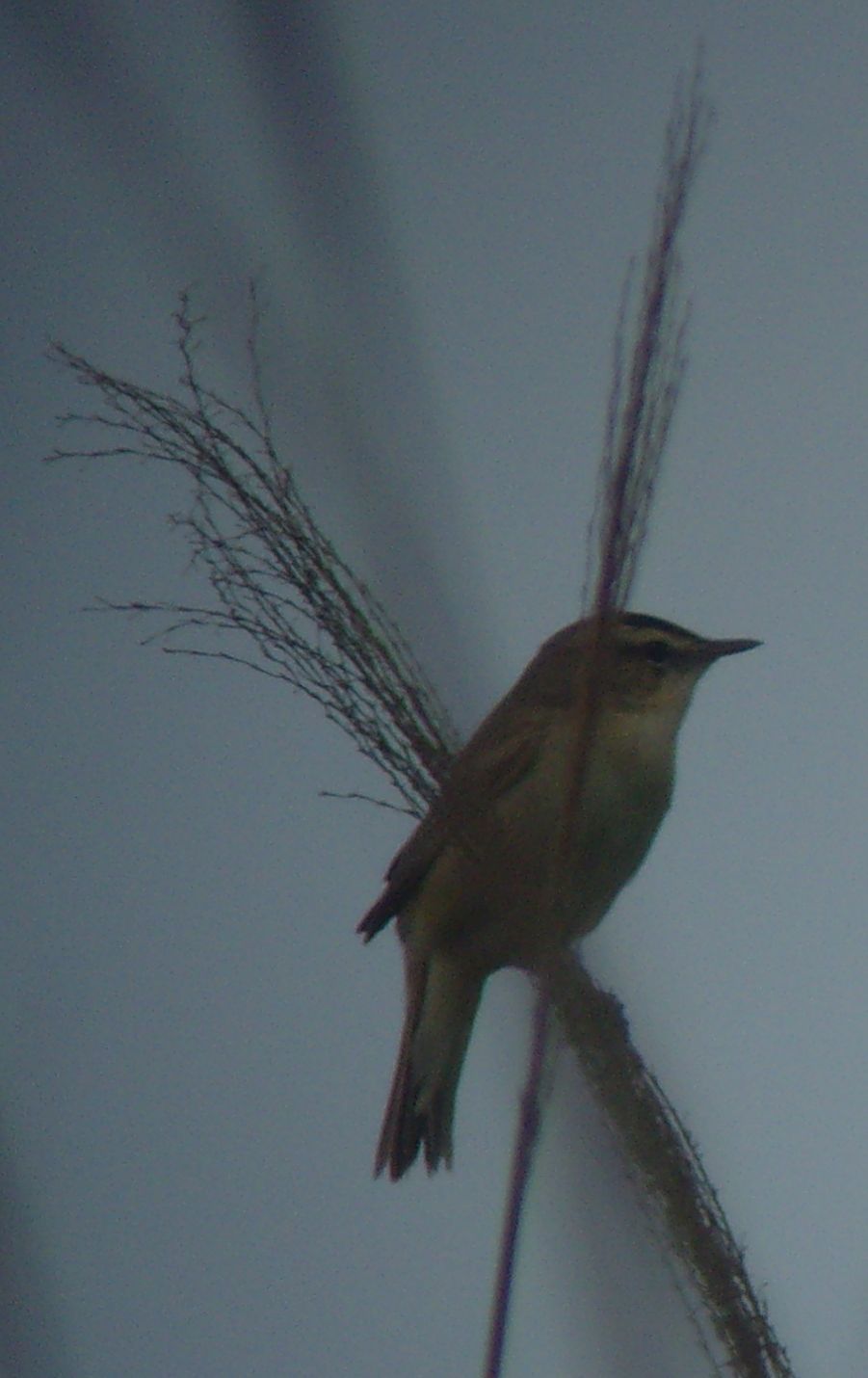
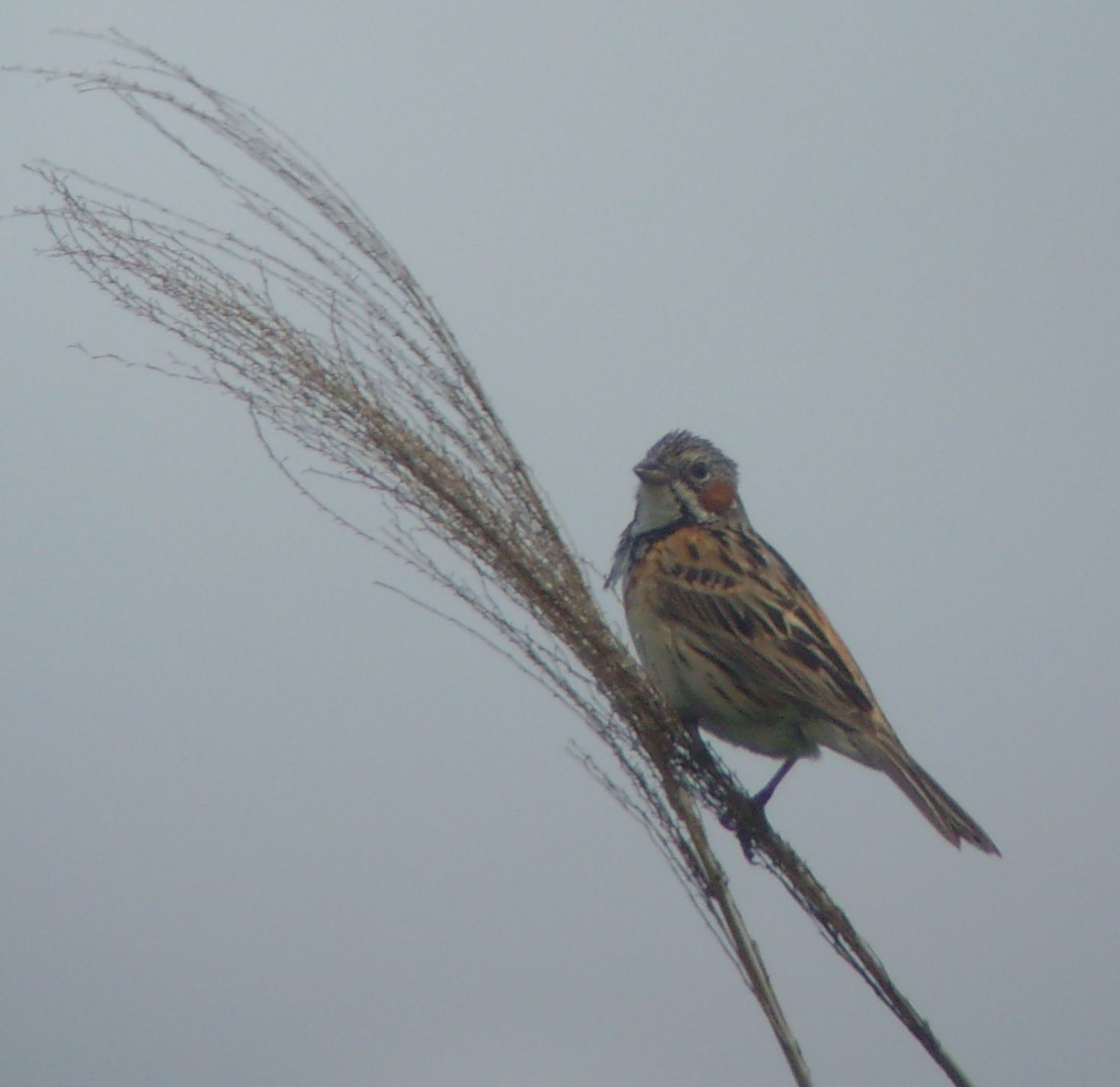
Black-browed Reed Warbler and Grey-headed Bunting
Sunday, June 7th, 2009
Today we joined the Ornitho birding group from Kamakura on an expedition to Mount Fuji. It was a long birding day, but we saw a lot of special birds-- White-bellied Green Pigeon (at Oiso en route), Japanese Yellow Bunting, Northern Hawk-Cuckoo, Blue-and-white, Narcissus and Asian Brown Flycatchers, Black-browed Reed Warbler, Grey-headed Bunting, and at a hidden spring at last light, a gathering of thrushes: Brown-headed Thrush, Grey (Japanese) Thrush, Siberian Thrush, and Siberian Blue Robin.


Black-browed Reed Warbler and Grey-headed Bunting
Sunday, April 19th, 2009
On this nice spring day, we travelled out to Ukishima Marsh in Ibaraki prefecture to see what was around. It was a little early in the year, but we got some good looks at Marsh Grassbirds and Japanese Reed Buntings, and the sky was full of Zitting Cisticolas. There was a lone Eastern Marsh Harrier remaining from the two dozen or so that roosted and hunted there this winter, and there were a few Pacific Golden Plovers and four Whimbrels in passage.
Sunday, March 22nd, 2009
We visited the Sagami River and the Sagami Reservoir (near Sobudaishita) today-- and a miserable, rainy and windy day it was! It was very difficult to weather the conditions and look for birds, but we did admire five male Falcated Ducks on the river and as many male Mandarin Ducks at the reservoir.
Sunday, February 8th 2009
In the afternoon, we visited Maioka Park in Totsuka-ku (Yokohama) to see the two Eurasian Woodcocks that have been resting there in plain sight during the day. What beauties!
Sunday, February 1st, 2009
Today we went to three locations on Tokyo Bay: Kasairinkai Koen, Yatsu-higata, and Sanbanse. It was rather cold and windy on the bay. Lots of ducks and several wintering shorebird species, and we were able to have good looks at a Saunder's Gull, a female Red-breasted Merganser, and a beautiful male Common Goldeneye at Sanbanse.
Wednesday - Friday, December 31st, 2008 - January 2nd, 2009
Ukishima, Hasaki, and Choshi. New Year's 2009 was sunny, cold and windy.
Ukishima area: We counted 54 Taiga Bean Geese this year, where there have usually been 60-70. The rice and lotus fields yielded about 20 Common Snipe and 2 Latham's Snipe, 15 Wood Sandpipers, 5 Pacific Golden Plovers, 2 Black-winged Stilts, a Dunlin and a Temminck's Stint. Lots of Grey Herons (I counted 88) and Northern Lapwings. On Kitaura Lake, a flock of 40 Falcated Ducks and a Black Swan (no, this cannot be added to our native bird list). 15 sightings of Eastern Marsh Harriers, 2 Northern Harriers, 14 Common Buzzards.
Hasaki: There was a paucity of seabirds, with only a single alcid (Common Murre), no jaeger and relatively few seaducks sighted (some 100 Black Scoters and only 2 White-winged Scoters), with few individuals of 2 species of diver (Arctic Loon and Red-throated Diver). Very few shorebirds-- only 8 Sanderlings and 4 Kentish Plovers.
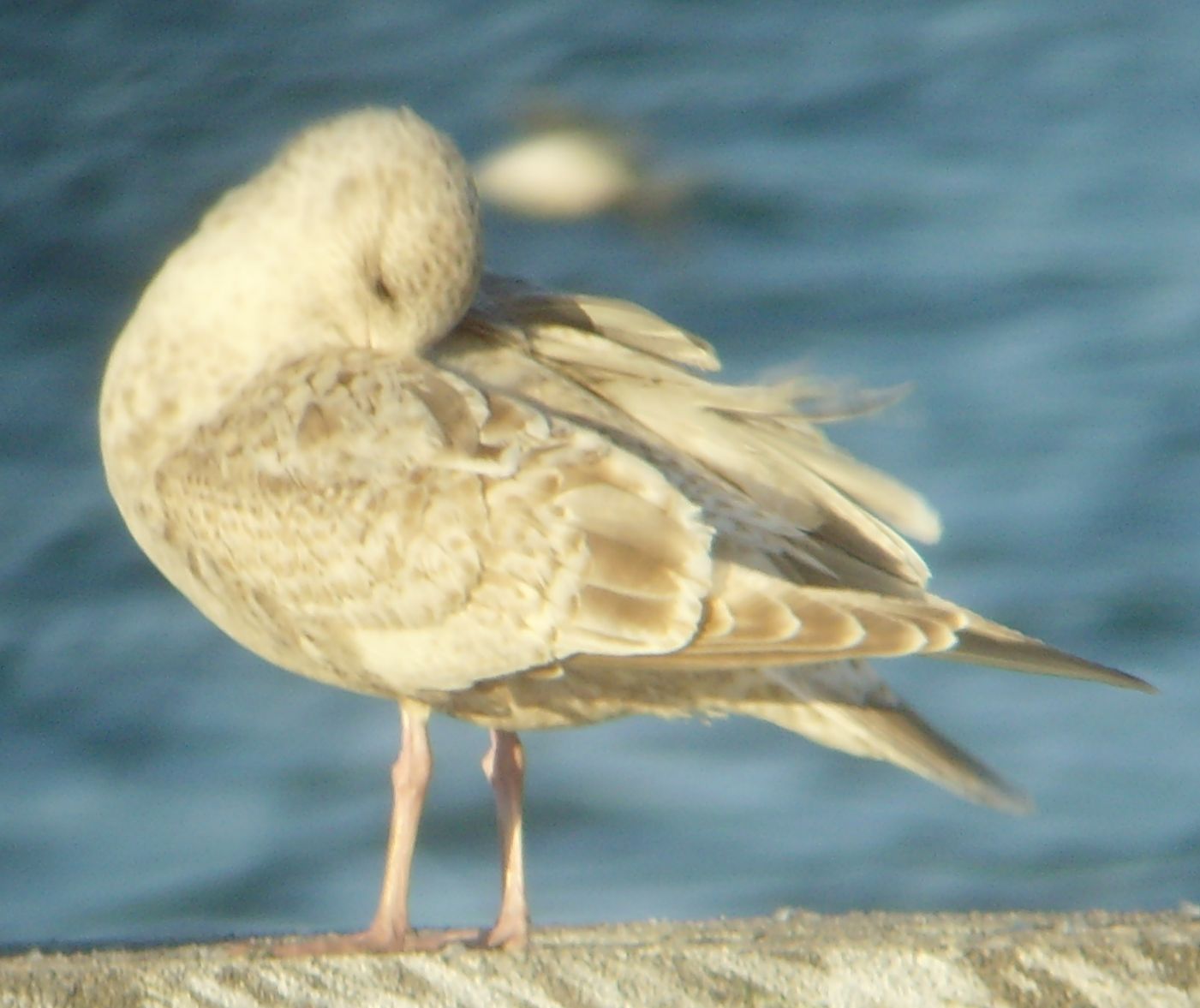
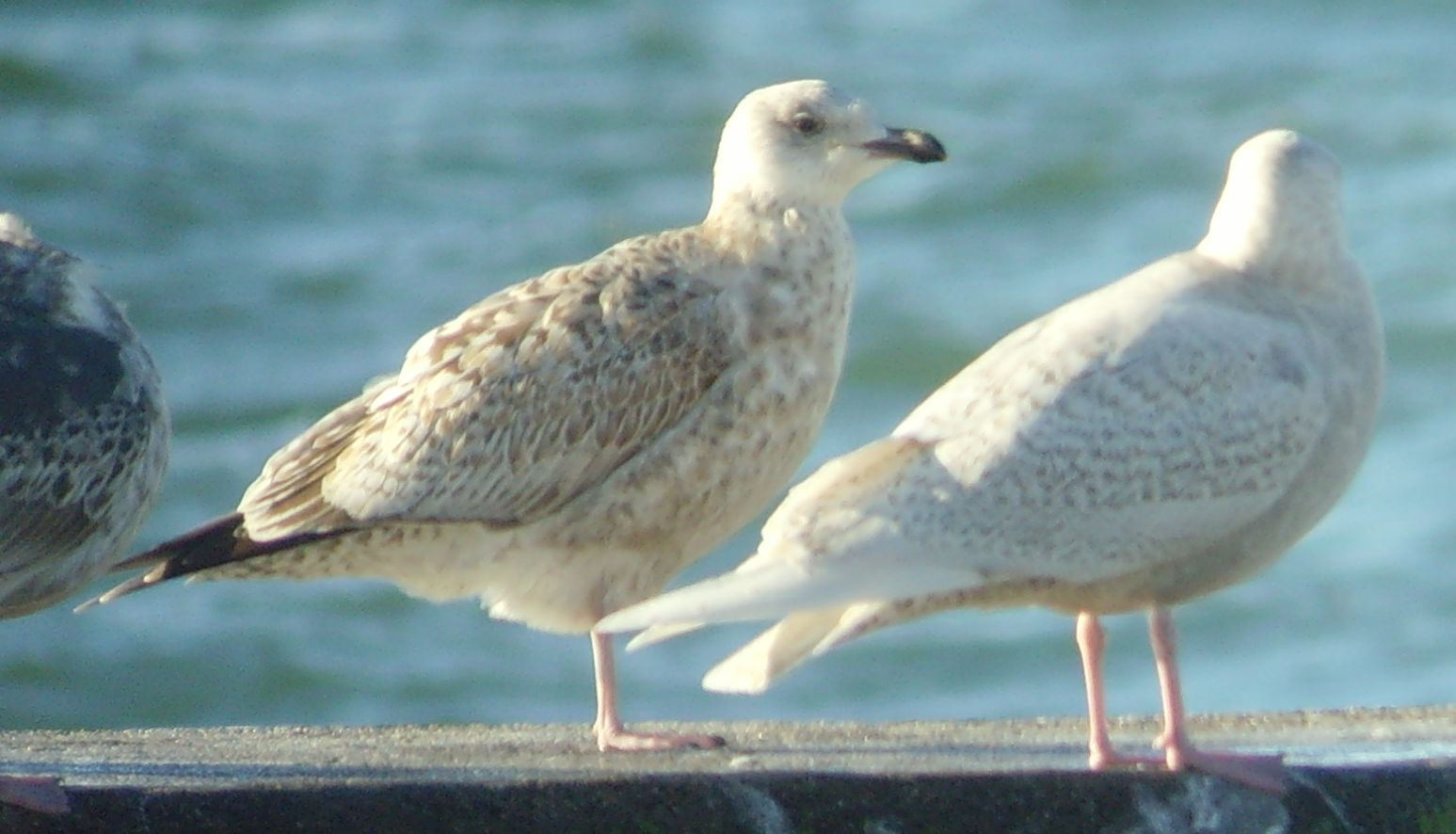
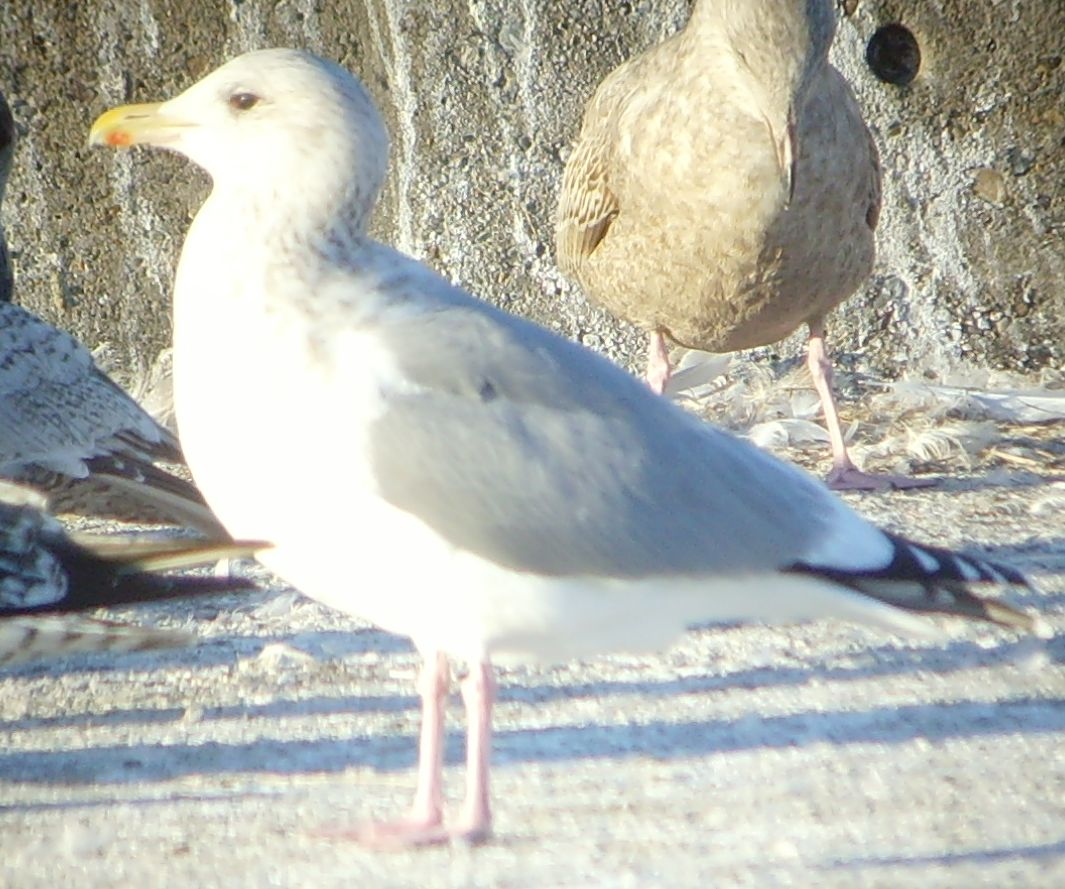
L to R: Glaucous-winged Gull (1st W), Slaty-backed and Glaucous Gulls (1st W), and Thayer's Gull (Ad W)
Choshi: Lots of gulls generally, but no adult Glaucous or Glaucous-winged seen, only a few first-winter birds. One adult Thayer's, several Common Gulls, and there seemed to be more Black-legged Kittiwakes than usual-- I counted 24. With all the gulls about, no doubt other observers have located other uncommon individuals. Other notable birds: 3 Eastern Reef Egrets and a male American Wigeon. Relatively few ducks (though 4 Harlequin Ducks is more than we have seen in the last few years).
Sunday, November 2nd, 2008
A beautiful autumn day in the Ukishima Marsh area of Ibaraki, warm in the mellow sunshine, with the goldenrod and silver grass both fading from flower to fluff. There were very few ducks on the lake yet, but a number of wintering land birds have appeared. An Eastern Marsh Harrier, 80 Northern Lapwings, and five Wood Sandpipers were the most interesting-- except for the Japanese Quail that flushed from underfoot while we were crossing a narrow grassy path between rice paddies! It flew low for a short distance and then dropped into a more inaccessible strip of weeds, where it disappeared, but we got a good look at its boldly striped back: it looked like a small, bill-less snipe.
Sunday & Monday, October 12th & 13th, 2008
Warm and sunny at Irago-misaki, Aichi, where we did our semi-annual hawk watch. It was the dribble end of migration, so not the 1000s of raptors that birders saw in late September, but still a decent range of species in the mornings (7-11 am) as the land heated and the air rose. It's lots of fun (and very easy) just to stand in the autumn morning sunshine on the tip of a peninsula and wait for whatever might pass. The two numbers are the two mornings:
Osprey 5, 5 Grey-faced Buzzard 28, 18 Crested Honey Buzzard 3, 4 Common Buzzard 20, 9 Northern Sparrowhawk 3, 3 Japanese Sparrowhawk 10, 10 Goshawk 1, 0 Peregrine 4, 0 Eurasian Kestrel 4, 2Also, lots of songbirds passing through. Every time we go, there seem to be different relative abundances (this time, for instance, hundreds of Oriental Turtle Doves and not a single Jay), but we've been to Irago-misagi now at several different stages during migration season, and no matter how the songbird migration varies, it seems that vast numbers of Brown-eared Bulbuls are always passing through. We guesstimated that flocks of from 100-500 individuals were flying through at about 50-60 flocks per hour, so that I was seeing 12,000-15,000 birds per hour, or anywhere between 50,000 and 100,000 bulbuls each morning. And that goes on for a month or so.
Sunday, July 13th, 2008
Hot, hot, hot, but we went over to the Sagami River at Sobudaishita just to see if any birds were about. There were a few, the regulars, but the river was too high to locate any Long-billed Plovers this time (when the government sets the level high, the gravel islands above the dam disappear beneath the surface). We were rewarded with a Striated Heron. It was more common here 15 years ago, but now only the occasional young bird (or post-breeding wanderer) appears down here from farther up the river; it is a more common summer species in the Hadano area.
Saturday & Sunday, July 5th & 6th, 2008
Hot sunny weather even up here at the higher altitude of Karuizawa. We saw a very nice range of summering species-- Red-cheeked Mynas, Japanese Grosbeaks, a Siberian Blue Robin, Narcissus Flycatchers, Blue-&-white Flycatchers, Winter Wrens (singing lustily-- actually, everything was still singing quite actively in the early morning), Grey Thrushes and a Siberian Thrush, Common and Oriental Cuckoos, and Japanese Robins, plus many species that we also find lower down around Yokohama and Tokyo.
Wednesday, June 11th, 2008
We took a rare weekday morning to run down to Futagoyama (near Zushi) to get our annual look at a Japanese Paradise Flycatcher, and this time we saw a gorgeous male! Also several Blue-&-white Flycatchers and Eastern Crowned Willow Warblers, and two Japanese Green Woodpeckers.
Sunday, June 8th, 2008
Today we went to see the Nordemann's Greenshank that appeared a day or two ago at Sanbanse (Funabashi KK, Chiba). He was easy to find, with a small and diverse group of shorebirds-- both Great and Red Knots, a few Grey and Kentish Plovers, and a couple of Dunlin. Lucky that we arrived at 11 am and found the bird, because at noon the gates were opened and a horde of clam diggers swarmed onto the mudflats, spooking all the shorebirds, who disappeared down the coast.
Monday, May 5th, 2008
Perhaps my favorite annual trip: to Ukishima Marsh to hear the birdsong. Early in the morning it is a glorious symphony of Japanese Reed Buntings, Japanese Marsh Warblers, Fan-tailed Warblers, Oriental Reed Warblers (Black-browed Reed Warblers seem to be disappearing from this location-- we saw none this time), Japanese Skylarks and Meadow Buntings. We also found two Spotted Redshanks in one of the rice fields

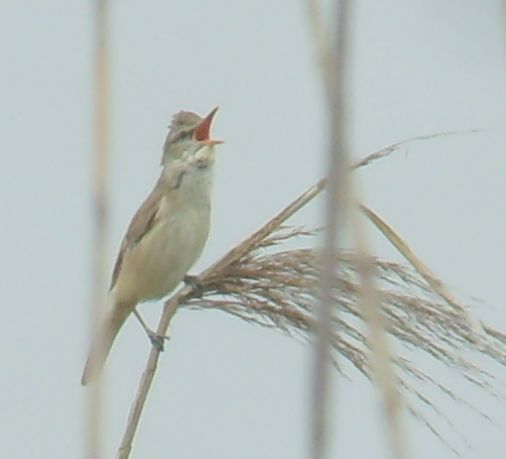
Monday, April 28th, 2008
This morning we took a quick trip to Seya Ward Citizens' Forest to see what spring was bringing to this suburban area. Lots of the usual active, notably 3 Green Pheasants, a Green Woodpecker, 20 Hawfinches, a Great Reed Warbler (who won't stay around) and a surprise Grey-faced Buzzard-Eagle passing over.
Monday - Wednesday, December 31st - January 2nd, 2007/08
This was our traditional New Year's year-list-starter trip to Ukishima, Hasaki and Choshi. This year we saw 76 species-- not as good as some years. Still, some great birds: Whooper Swans and Bean Geese (60 counted this year), Eastern Marsh & Northern Harriers, Common Buzzards, 3 Oystercatchers, a Pomerine Jaeger and some Ancient Murrelets, all five grebes (Little, Great Crested, Eared, Horned & Red-necked), two Eastern Reef Egrets and an American Herring Gull.
Sunday, November 4th, 2007
On this beautiful sunny and mild autumn morning-- shirtsleeve weather!-- we went over to the Sagami River near Sobudaishita and to Sagami Reservoir to check out the action. Few ducks have arrived yet, but there were several Tufted Ducks, Eurasian Wigeons, Mallards, Shovellers and Gadwall, and a good number of Common Teal. Most interesting was a large group of Long-billed Plovers (nine individuals) resting and preening on one of the small gravel islets above the weirs.
Friday, August 31st, 2007
We went to Sanbanze (Funabashi Keihin Koen) this morning from 10:00-11:30 and saw 17 species of shorebirds: Little Ringed Plover, Kentish Plover, Lesser Sandplover, Pacific Golden-Plover, Great Knot, Sanderling, Red-necked Stint, Curlew Sandpiper, Dunlin, Spoon-billed Sandpiper, Broad-billed Sandpiper, Ruff, Bar-tailed Godwit, Whimbrel, Terek Sandpiper, Grey-tailed Tattler and Ruddy Turnstone.
I haven't had many birding days as glorious as this-- what a great pleasure to lounge on the shore or wander over the mudflats searching among all the variety of shorebirds as they skitter about feeding, or pause to preen.
Friday, May 11th, 2007
A beautiful morning, cool and sunny, after last night's rainstorm, and we went to Futagoyama to see if we could find any Japanese Paradise-Flycatchers. We did find one female, singing actively close overhead. We also saw a singing male Blue-and-White Flycatcher, and watched an aggressive Eastern Crowned Willow Warbler chasing White-eyes. Far overhead, White-rumped Swifts circled. One of the greatest attractions today were the many brilliant red-and-turquoise tiger beetles that seem to love the sunny patches on the forest path.
Friday, April 13th, 2007
Today we went to the Tama River mouth, across from Haneda Airpost and where the Isuzu plant used to be. This property is now a parking lot. Last year, it was gravelled and empty, and supported nesting Little Terns, but this year, the terns may be out of luck.
It is too early for much migration, and there were still many wintering ducks, mostly Greater Scaup (about 300 of these). Other winter birds were Dusky Thrush, Vega Gull (20) and Spot-billed Duck (which will be moving to small streams or upriver for breeding). Signs of spring were the Barn Swallows and a flock of about 70 Mongolian Plovers approaching breeding plumage; there was also an unusual Greater Sandplover, ganglier and longer-nosed than the Mongolian Plovers, with long, yellowish legs.
Friday, January 19th, 2007
MM's English Birdwalks went to two sites today-- Kasairinkaikoen and Funabashi Keihinkoen. It was cold and windy, but the blue sky and sunshine made it a lovely day. At Kasairinkai, vast flocks of Eared Grebes and Greater Scaups were milling about in the open water, and we found the Saunders's Gull hunting along the inner waterway and a Slaty-backed Gull standing like a lord on the beach. The lack of distinctive white triangles on the upper wing (a Black-headed Gull characteristic) makes Saunders's Gull easy to identify at a distance.
At Funabashi KK, the tide was out, and the mudflats were covered with shorebirds: Eurasian Curlew (6), Sanderling (+/- 50), Rufous-necked Stint (4), Dunlin (+/- 1500), Eurasian Oystercatcher (109), Grey Plover (+/- 50), and Kentish Plover (+/- 60). There was also a Saunders's Gull harassing the Dunlins.
By mid-morning, the wind had died down, and it was a beautiful experience walking out among the shorebirds on the flats; there were only two or three clamdiggers to disturb the birds.
Friday, November 10th, 2006
Our inaugural bird walk to Oi Bird Park was on a beautiful Indian Summer day. Wintering ducks have started to arrive, and we saw 7 kinds. We also saw the first Dusky Thrush (Tsugumi) of the season and some migrating Jays (Kakesu). We missed the low tide, though, so there were no shorebirds. The goldenrod is just coming into bloom.
